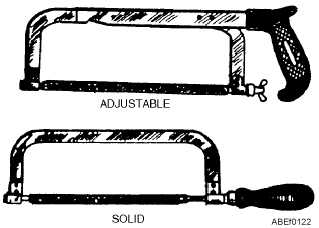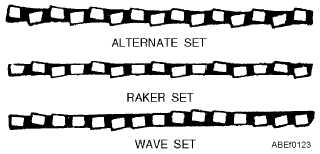Safety and Care
Learn to use snips properly. They should always be
oiled and adjusted to permit ease of cutting and to
produce a surface that is free from burrs. If the blades
bind or if they are too far apart, the snips should be
adjusted. Remember the following safety tips:
Never use snips as screwdrivers, hammers, or
pry bars. They break easily.
Do not attempt to cut heavier materials than the
snips are designed for. Never use tin snips to cut
hardened steel wire or other similar objects.
Such use will dent or nick the cutting edges of
the blades.
Never toss snips in a toolbox where the cutting
edges can come into contact with other tools.
This dulls the cutting edges and may even break
the blades.
When snips are not in use, hang them on hooks
or lay them on an uncrowded shelf or bench.
HACKSAWS
Hacksaws are used to cut metal that is too heavy for
snips or bolt cutters. Thus, metal bar stock can be cut
readily with hacksaws.
There are two parts to a hacksaw: the frame and the
blade. Common hacksaws have either an adjustable or a
solid frame (fig. 1-12). Most hacksaws found in the
Navy are of the adjustable-frame type. Adjustable
frames can be made to hold blades from 8 to 16 inches
long, while those with solid frames take only the length
blade for which they are made. This length is the
distance between the two pins that hold the blade in
place.
Hacksaw blades are made of high-grade tool steel,
hardened and tempered. There are two types, the
all-hard and the flexible. All-hard blades are hardened
throughout, whereas only the teeth of the flexible
blades are hardened. Hacksaw blades are about
1/2-inch wide, have from 14 to 32 teeth per inch, and
are from 8 to 16 inches long. The blades have a hole at
each end, which hooks to a pin in the frame. All
hacksaw frames, which hold the blades either parallel
or at right angles to the frame, are provided with a
wingnut or screw to permit tightening or removing the
blade.
The SET in a saw refers to how much the teeth are
pushed out in opposite directions from the sides of the
blade. The four different kinds of set are the
ALTERNATE
set,
DOUBLE
ALTERNATE
set,
RAKER set, and WAVE set. Three of these are shown
in figure 1-13.
The teeth in the alternate set are staggered, one to
the left and one to the right throughout the length of the
blade. On the double alternate set blade, two adjoining
teeth are staggered to the right, two to the left, and so
on. On the raker set blade, every third tooth remains
straight and the other two are set alternately. On the
wave (undulated) set blade, short sections of teeth are
bent in opposite directions.
Using Hacksaws
The hacksaw is often used improperly. Although it
can be used with limited success by an inexperienced
person, a little thought and study given to its proper use
will result in faster and better work and in less dulling
and breaking of blades.
Good work with a hacksaw depends not only upon
the proper use of the saw but also upon the proper
1-11
Figure 1-12.—Hacksaws.
Figure 1-13.—"Set" of hacksaw-blade teeth.





